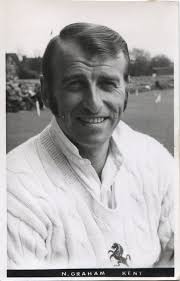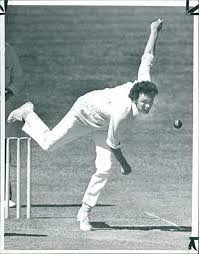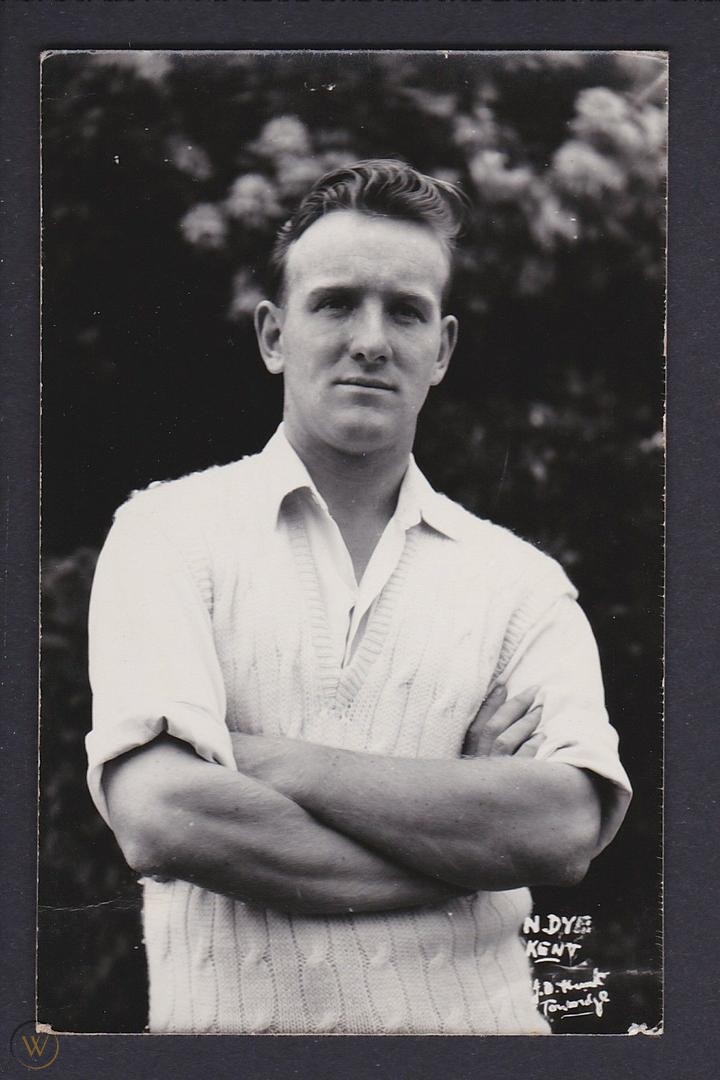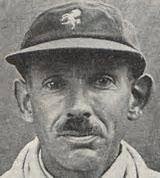

Big Norman Graham (left) and Kevin Jarvis (right), two of Kent’s better bowlers and lesser batsmen
The 1976 Wisden, in its summary of Kent’s year in 1975, summed up by saying, “Much will depend on the fitness of Graham and the ability of Jarvis to maintain his high hopes if the attack is to be successful. If it is, then Kent can lift some honours somewhere.” These two men are remembered fondly by Kent fans for their excellent and penetrative bowling for the county over many years, and also, for completely different reasons, for their batting. By the time the pair hung up their bowling boots, they both boasted a total tally of wickets far in excess of their total tally of runs, a feat that has not been achieved by many who have played as many games as they have.
For three seasons, 1975, 1976 and 1977, John Norman Graham and Kevin Bertram Sidney Jarvis were both on the Kent staff, yet they played together comparatively rarely. The first occasion was at Maidstone, in June 1975, when Kent played Sussex and won by an innings and 10 runs. This was John Shepherd’s match – he scored 52 in Kent’s innings of 329, in between taking 8-93 and 7-54 in a total of 71.5 overs, so the performances of Graham and Jarvis (Graham 1-56, Jarvis 1-51) were hardly crucial, but even in this match they managed to take more wickets than they scored runs. Jarvis, batting at number ten for the only time when he played with Graham, was out for a duck, leaving Big Norm on 0 not out. Thereafter, the Kent selectors decided that Kevin was their natural number eleven and he hardly ever budged from that position. By the end of that summer, Jarvis had scored as many as 14 runs at an average of 3.50, while Graham had scored 5 runs (HS 5*) at an average of 1.66. But Jarvis had taken 40 wickets in 13 matches, and Graham, in a season cut short by injury, had taken 23 in eight matches.
The next season proved that without doubt, Graham was the better batsman. In 1976, Jarvis made 23 runs with a top score of 7, but Graham’s top score was a vastly superior 7 not out. His batting average was also much better, 2.83 as compared to 2.55 by Jarvis. Graham’s season was limited again by injury, to just eight games, in which he took 21 wickets, while Jarvis took 34. Kent’s first championship game of the season, against Middlesex at Lord’s, featured both men having unusual success with the bat. This was where Graham made his season’s best 7 not out, and put on 47 for the ninth wicket, mainly thanks to John Shepherd’s 57 at the other end, but even when Jarvis came in to join his fellow tailender, the innings was not yet over. They put on all of 2 runs for the last wicket, both off the Jarvis bat. Despite these heroics, Middlesex won by 97 runs. Against Worcestershire at Worcester a few days later, Norman Graham scored 1 not out (possibly the winning run as Kent got home by three wickets), but even though Luckhurst, Johnson and Denness were all injured during the course of the match and struggled to bat, Jarvis was not asked to put on his pads. He took four wickets, though, and a catch to account for Basil d’Oliveira, c Jarvis b Graham.
1977 was the final season for Norman Graham, and also the year that Kevin Jarvis was awarded his county cap. Graham played in just one match, against Surrey at The Oval in July. He did not bat but took one wicket for 40 runs in this his 186th game for the county, to stretch his wicket tally even further ahead of his runs. Jarvis, ten years his junior, ended the season with just 8 runs in 19 games (ave 4.00), but somehow still finished above Derek Underwood in the county averages (25 runs at 2.77).
Norman Graham made his highest first-class score of 23 against Cambridge University in 1968, the year after he made his highest county championship score of 20, against Surrey at the Oval, where a decade later he played his final match. It is worth noting that for the first part of his career, he usually batted above John Dye, another who scored fewer runs than he took wickets for Kent – 316 runs and 371 wickets. However, when Dye moved to Northamptonshire, his form with the bat was transformed, so that he ended his career with 774 runs and only 725 wickets. Opposition bowling attacks must have sighed with relief when, once they had got past Denness, Luckhurst, Cowdrey, Asif, Woolmer, Ealham, Shepherd and Knott among others, they knew that there were two men at numbers ten and eleven who frankly hardly knew which end of the bat to hold. And it may explain why we let David Gower go to Leicestershire with a batting line-up of that quality already available.

John Dye, before he decamped to Northamptonshire
Kevin Jarvis was another whose batting got better once he switched counties. His move to Gloucestershire for his final couple of seasons saw him improve on his highest score, which for Kent had been a mere 19, against Derbyshire at the Mote in 1984. For Gloucestershire against Hampshire in Portsmouth at the end of July 1989, he hit no less than 32. His score came in the first innings, but unfortunately he could not repeat it in the second innings, slumping back to a more familiar duck, as Gloucestershire stumbled to an innings defeat.
Norman Graham finished his career with 408 runs and a batting average of 3.88, while Kevin Jarvis, for Kent, could only manage 321 at 3.17. That is only three runs more in a thirteen seasons than Sean Dickson managed in one innings against Northants at Beckenham in 2017. Clearly Big Norm has bragging rights. John Dye, incidentally, had a Kent career average of 5.18, but by the time he had retired after several seasons at Northamptonshire, this had risen to the heady heights of 6.34.

Father Marriott, dreadful batsman, poor fielder, great bowler, wonderful gentleman
All three men gave Kent fans many happy memories, and often as much with the bat as with the ball, although they bowled longer than they batted. They were, perhaps, worthy successors to Charles ‘Father’ Marriott, who played for Kent from 1924 to 1937 and ended his career with 356 runs and 463 wickets. Who will be the next player to achieve this feat? Perhaps it will never be done, but I rather hope that cricket will never give up on bowlers who bowl even if they can’t bat.
Wonderful writing about times gone by. I was a warwickshire supporter but we’ll remember those fine Kent players – even if some weren’t the best batsmen!
Thanks!
Thanks for your kind comments.